
Castello di Compiano is a castle at the top of Compiano's hill, in the province of Parma, northern Italy.

Castello di Compiano is a castle at the top of Compiano's hill, in the province of Parma, northern Italy.
It is believed to have been built in the early Middle Ages by the Lombards, on the road which links the neighbouring Emilia and Liguria. It first belonged to the Malaspina family, then to the Commune of Piacenza and, finally, to the Landi family which ruled the area for 425 consecutive years, eventually forming a small independent principality, the Landi State.
Between the 16th and the 17th centuries, Compiano was in its prime, and minted its own currency, opened state schools and started a pawn system. In the 18th century Compiano passed from the Farnese to the Borbone family, and was then annexed to the realm of Maria Luigia of Austria, then Duchess of Parma, who used the castle as a State prison for Carbonari captives in 1821.
Before World War II it was used as a girls' orphanage. After the war ended, the school was closed down and the castle was bought by Marchioness Lina Raimondi Gambarotta who, after her death in 1987, left it to the Compiano municipality.
Built on a rocky spur which dominates the river Taro, the castle is similar to a projection from the surrounding fortified walls. [1]
Since July 2002, the castle hosts the International Masonic Museum Orizzonti Massonici, the only museum of this kind in Italy. The three rooms dedicated to this museum contain precious relics, such as medallions, paintings, and honours belonging to the British Masonic symbolism used in the 18th and 19th Century; one of the rooms, called room 33, holds various Italian relics and objects displayed by the Italian Masonic association Grande Oriente d'Italia - Palazzo Giustiniani. [2]
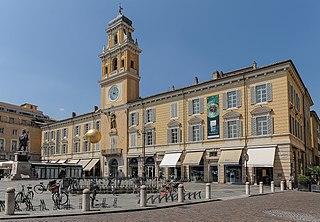
Parma is a city in the northern Italian region of Emilia-Romagna known for its architecture, music, art, prosciutto (ham), cheese and surrounding countryside. With a population of 198,292 inhabitants, Parma is the second most populous city in Emilia-Romagna after Bologna, the region's capital. The city is home to the University of Parma, one of the oldest universities in the world. Parma is divided into two parts by the stream of the same name. The district on the far side of the river is Oltretorrente. Parma's Etruscan name was adapted by Romans to describe the round shield called Parma.

Caccamo is a town and comune located on the Tyrrhenian coast of Sicily in the Metropolitan City of Palermo.

The Province of Parma is a province in the Emilia–Romagna region of Italy. Its largest town and capital is the city of Parma.

The province of Chieti is a province in the Abruzzo region of Italy. Its provincial capital is the city Chieti, which has a population of 50,770 inhabitants. The province has a total population of 387,649 inhabitants as of 2017 and spans an area of 2,599.58 square kilometres (1,003.70 sq mi). It is divided into 104 comuni (comune) and the provincial president is Mario Pupillo.

The Castello Sforzesco is a medieval fortification located in Milan, northern Italy. It was built in the 15th century by Francesco Sforza, Duke of Milan, on the remnants of a 14th-century fortification. Later renovated and enlarged, in the 16th and 17th centuries it was one of the largest citadels in Europe. Extensively rebuilt by Luca Beltrami in 1891–1905, it now houses several of the city's museums and art collections.
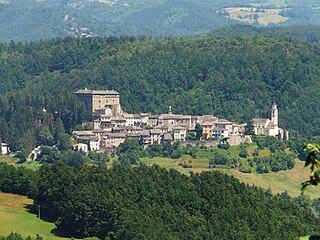
Compiano is a medieval walled town in the Taro Valley, a 50 minute-drive to the Ligurian Sea and to Parma.

The Palazzo Ducale di Mantova is a group of buildings in Mantua, Lombardy, northern Italy, built between the 14th and the 17th century mainly by the noble family of Gonzaga as their royal residence in the capital of their Duchy. The buildings are connected by corridors and galleries and are enriched by inner courts and wide gardens. The complex includes some 500 rooms and occupies an area of c. 34,000 m², which make it the sixth largest palace in Europe after the palaces of the Vatican, the Louvre Palace, the Palace of Versailles, the Royal Palace of Caserta and the Castle of Fontainebleau. It has more than 500 rooms and contains 7 gardens and 8 courtyards. Although most famous for Mantegna's frescos in the Camera degli Sposi, they have many other very significant architectural and painted elements.

Collecchio is a town in the province of Parma, Emilia-Romagna, northern Italy. It is located 12.9 kilometres (8.0 mi) by road southwest of the centre of Parma. A major food-producing area, it is home to multinational Italian dairy and food corporation Parmalat and the Parma F.C. training complex, Centro Sportivo di Collecchio, and is connected by railway. Under the Romans the town was called Sustrina, Later, in Christian times it was called, Colliculum, because of its location on a small hill. In 2015, Collecchio became recognized as the first community to mandate that all fireworks set off in the town be silent.

Bardi is a comune (municipality) in the Province of Parma in the Italian region Emilia-Romagna, located about 130 kilometres (81 mi) west of Bologna and about 50 kilometres (31 mi) southwest of Parma, in the upper Ceno valley at the confluence of the rivers Ceno and Noveglia. It is dominated by the imposing Landi Castle built over a spur of red jasper.

Torrechiara Castle is a 15th-century castle near Langhirano, in the province of Parma, northern Italy. It sits atop a terraced hill south of the city of Parma, in a strategic position overlooking the Parma River in the valley below. The castle was commissioned by Pier Maria II de' Rossi, the fourth count of San Secondo, and built between 1448 and 1460. The fortress shows the influence of the Sforza-Visconti castles. In 1894, it was described as "the two walls, the curtains planted on an exact square, and the four towers draw together like a cyclopean pyramid very pleasing to the eye and, in fact, very elegant" by archaeologist and art historian Corrado Ricci. The castle has been managed by the Polo Museale dell'Emilia Romagna since 2015.
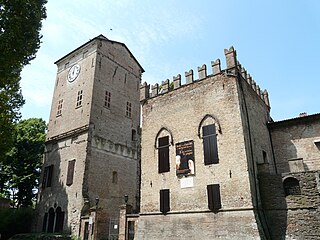
Rocca dei Rossi is a castle located at piazza Mazzini #12 in the town of San Secondo Parmense, province of Parma, in the Italian region Emilia-Romagna. A different Rocca dei Rossi, also known as Castello di Roccabianca, is located in the town of Roccabianca.
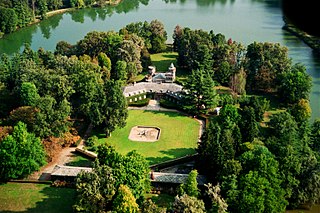
La Mandria Regional Park is a park in the comuni of Venaria Reale and Druento, near Turin, northern Italy. Founded in 1978 by the regional council of Piedmont, it occupies a wide area between the Stura di Lanzo torrent and the north-western part of Turin and Venaria.
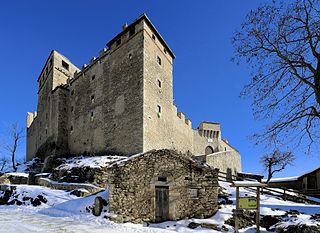
The Castello di Montecuccolo is a castle in Pavullo nel Frignano, Modena, Italy.

The Landi were a noble family from Piacenza, in northern Italy. From 1551 to 1582, they were princes of the Val di Taro, now in the province of Parma, at that time in papal territory. Their principality is sometimes called Lo Stato Landi ; although the term is not well known, there is substantial documentation of it in the Archivio Segreto Vaticano, in the Vatican City.

The Castello or Castle of Roccabianca, also called Rocca dei Rossi, is a castle built in the town of Roccabianca, province of Parma, Emilia Romagna, northern Italy.

The Visconti Castle or Castello Visconteo is a castle in the town of Cusago near Milan, Lombardy, Northern Italy. It was built in the 14th century by Bernabò Visconti and used as a hunting lodge by him and other members of his family. The castle underwent significant changes in the Renaissance period. Today it is in a state of neglect.

The Castle of the Pico is a castle in the city center of Mirandola, in the province of Modena, Italy.
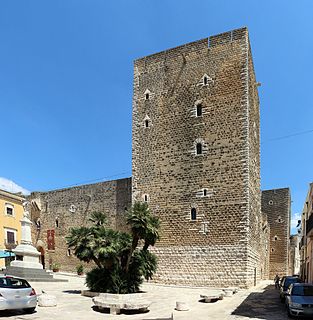
The Castello Normanno-Svevo is a Normans' castle located in the historic center of Gioia del Colle. Since December 2014, the Ministry of Cultural Heritage and Activities has managed the entire castle through the Polo Museale della Puglia, which, in December 2019, became the Direzione Regionale Musei.

The Visconti Castle of Pavia is a medieval castle in Pavia, Lombardy, Northern Italy. It was built after 1360 in a few years by Galeazzo II Visconti, Lord of Milan, and used as a sovereign residence by him and his son Gian Galeazzo, first duke of Milan. Its wide dimensions induced Petrarch, who visited Pavia in the fall of 1365, to call it "an enormous palace in the citadel, a truly remarkable and costly structure". Adjacent to the castle, the Visconti created a vast walled park that reached the Certosa di Pavia, a Carthusian monastery founded in 1396 by the Visconti as well and located about 7 kilometres (4.3 mi) to the north.